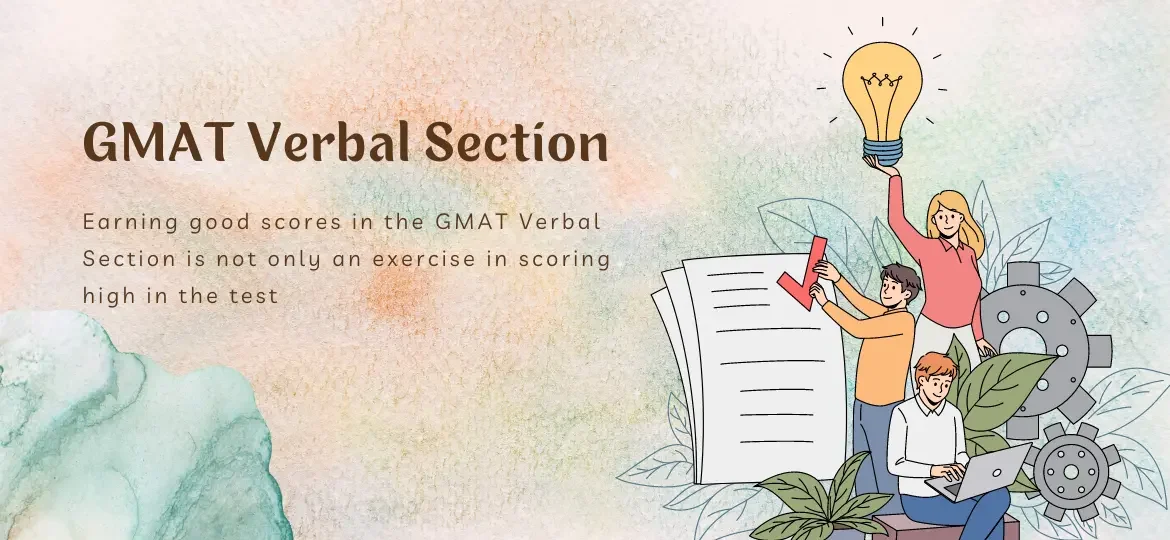
Understanding the GMAT Verbal Section
Mastering the GMAT Verbal Section becomes a vital component to a high overall GMAT score. This section tests your critical reading skills, the ability to develop arguments, and the depth of your knowledge about the English language. If you want to achieve success in this section, then you must employ the right strategy and practice. These essential GMAT verbal tips and strategies would help you to enhance your performance in the areas of Critical Reasoning, Reading Comprehension and Sentence Correction. Before diving into specific tips, it’s important to understand the structure of the GMAT Verbal Section. This section consists of three main types of questions:- Critical Reasoning (CR): Tests your ability to evaluate arguments and develop logical conclusions.
- Reading Comprehension (RC): Assesses your ability to understand and analyze written material.
- Sentence Correction (SC): Measures your understanding of grammar and effective communication.
Why Mastering the GMAT Verbal Section is Important
Earning good scores in the GMAT Verbal Section is not only an exercise in scoring high in the test. It also helps improve analysis and reporting skills, which are so important in business school and the job market. Enhancing your language skills can help you speak clearly and persuade others, reason more efficiently and critically evaluate information.Tips for Critical Reasoning
Understand the Argument Structure The initial part of the GMAT critical reasoning section is identifying the major components of an argument. In each argument there is a conclusion and premises, and in some cases, assumptions. Knowing these components enables one to determine the strength or weakness of an argument presented. Practice Active Reading There is nothing more effective than critical thinking which requires active reading. It is critical to be focused on the author’s attitude, intention, and the sequence of the comprise thoughts. To ease comprehension it may be useful to circle or underline the ideas reflected in the outline of the argument.Common Types of Critical Reasoning Questions
Familiarize yourself with the common types of critical reasoning questions, such as:- Strengthen/Weaken: Identify how additional information affects the argument.
- Assumption: Determine the unstated premise that supports the conclusion.
- Inference: Draw logical conclusions based on the given information.
- Evaluate: Assess the argument’s validity by examining the evidence.
- Identify the Conclusion: Start by identifying the conclusion of the argument. This will help you understand the argument’s main point.
- Find the Premises: Identify the premises that support the conclusion.
- Eliminate Irrelevant Information: Focus on the information that directly relates to the argument.
- Use the Process of Elimination: Eliminate answer choices that do not directly address the question.
Tips for Reading Comprehension
Develop Active Reading Habits The most important factors to help you understand the text better are question the text, predict what you think will happen next, or tell the story in your own words. This enables you to remember and comprehend the paragraph in an easier way. Identify the Main Idea The most important factors to help you understand the text better are question the text, predict what you think will happen next, or tell the story in your own words. This enables you to remember and comprehend the paragraph in an easier way. Pay Attention to Structure and Tone If you understand the structure, and tone of the passage, it can help with clues to infer what the author believes. Look at how the information is presented and the authorial voice given to the topic. Strategies for Answering Reading Comprehension Questions- Skim the Passage First: Skim the passage to get an overall understanding before diving into the details.
- Refer Back to the Passage: Refer back to the passage to find evidence for your answers.
- Eliminate Wrong Answers: Use the process of elimination to narrow down your choices.
- Practice Time Management: Allocate your time wisely to ensure you have enough time to answer all questions.
Tips for Sentence Correction
Understand Basic Grammar Rules You must have an understanding of basic grammar. Look to see where you tend to make mistakes first (i.e in subject-verb agreement, pronoun usage, verb tenses, modifiers and parallelism) Identify Common Error Types Familiarize yourself with common error types that appear in GMAT sentence correction questions, such as:- Subject-Verb Agreement: Ensure the subject and verb agree in number.
- Pronoun-Antecedent Agreement: Ensure pronouns agree with their antecedents.
- Verb Tenses: Use the correct verb tense for the context.
- Modifiers: Place modifiers correctly to avoid confusion.
- Parallelism: Ensure parallel structure in lists and comparisons.
- Read the Entire Sentence: Read the entire sentence to understand the context before identifying errors.
- Identify the Error Type: Identify the type of error in the sentence.
- Use the Process of Elimination: Eliminate answer choices that do not correct the error or introduce new errors.
- Consider Clarity and Conciseness: Choose the answer that is clear, concise, and grammatically correct.


